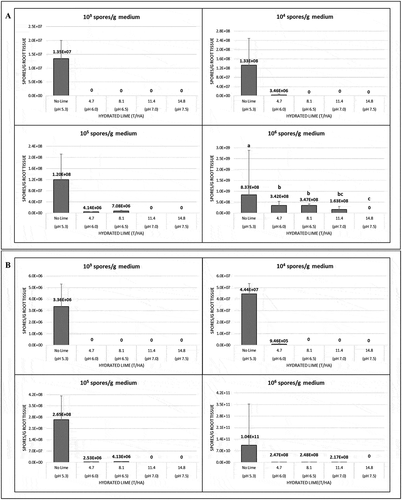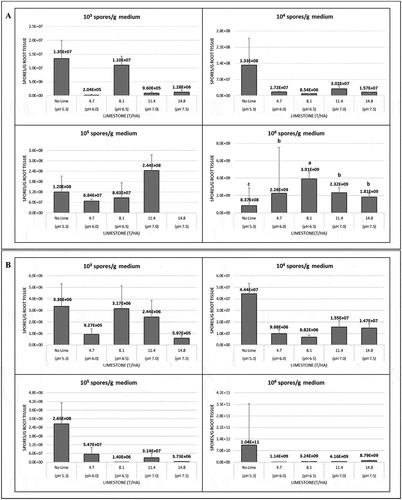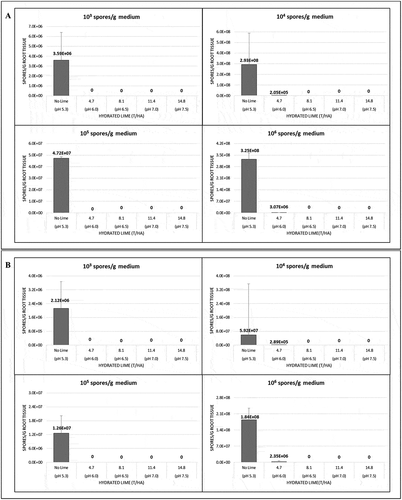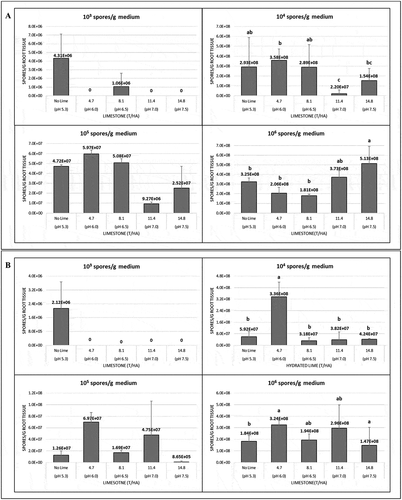Figures & data
Table 1. Effects of hydrated lime (Ca(OH)₂) on clubroot index of disease and plant growth parameters of the clubroot-susceptible canola ‘45H31ʹ under field conditions in Edmonton, Alberta, in 2017 and 2018.a
Table 2. Effects of hydrated lime (Ca(OH)₂) on clubroot index of disease (ID), canola plant height, dry shoot weight and dry root weight under greenhouse conditions 8 weeks after planting, in 2017 and 2018.a
Table 3. Effects of limestone (CaCO₃) on clubroot index of disease (ID), canola plant height, dry shoot weight and dry root weight under greenhouse conditions 8 weeks after planting, in 2017 and 2018.a
Fig. 1 The effects of hydrated lime in 2017 on the amount of Plasmodiophora brassicae in the roots of 10-day-old seedlings of the canola cultivars (a) ‘45H31ʹand (b) ‘9558C’ as determined by quantitative PCR analysis. The seedlings were grown under greenhouse conditions in potting medium inoculated with 1 × 103, 1 × 104, 1 × 105 and 1 × 106 resting spores g−1 potting medium and treated with 4.7, 8.1, 11.4 or 14.8 T ha−1 of hydrated lime, which targeted a pH of 6.0, 6.5, 7.0 or 7.5, respectively. Controls did not receive any lime (pH 5.3). Means with no letters do not differ; means differences are denoted by different letters at P < 0.05.

Fig. 2 The effects of limestone in 2017 on the amount of Plasmodiophora brassicae in the roots of 10-day-old seedlings of the canola cultivars (a) ‘45H31ʹ and (b) ‘9558C’ as determined by quantitative PCR analysis. The seedlings were grown under greenhouse conditions in potting medium inoculated with 1 × 103, 1 × 104, 1 × 105 and 1 × 106 resting spores g−1 potting medium and treated with 4.7, 8.1, 11.4 or 14.8 T ha−1 of limestone, which targeted a pH of 6.0, 6.5, 7.0 or 7.5, respectively. Controls did not receive any lime (pH 5.3). Means with no letters do not differ; means differences are denoted by different letters at P < 0.05.

Fig. 3 The effects of hydrated lime in 2018 on the amount of Plasmodiophora brassicae in the roots of 10-day-old seedlings of the canola cultivars (a) ‘45H31ʹ and (b) ‘9558C’ as determined by quantitative PCR analysis. The seedlings were grown under greenhouse conditions in potting medium inoculated with 1 × 103, 1 × 104, 1 × 105 and 1 × 106 resting spores g−1 potting medium and treated with 4.7, 8.1, 11.4 or 14.8 T ha−1 of hydrated lime, which targeted a pH of 6.0, 6.5, 7.0 or 7.5, respectively. Controls did not receive any lime (pH 5.3). Means with no letters do not differ; means differences are denoted by different letters at P < 0.05.

Fig. 4 The effects of limestone in 2018 on the amount of Plasmodiophora brassicae in the roots of 10-day-old seedlings of the canola cultivars (a) ‘45H31ʹ and (b) ‘9558C’ as determined by quantitative PCR analysis. The seedlings were grown under greenhouse conditions in potting medium inoculated with 1 × 103, 1 × 104, 1 × 105 and 1 × 106 resting spores g−1 potting medium and treated with 4.7, 8.1, 11.4 or 14.8 T ha−1 of limestone, which targeted a pH of 6.0, 6.5, 7.0 or 7.5, respectively. Controls did not receive any lime (pH 5.3). Means with no letters do not differ; means differences are denoted by different letters at P < 0.05.

